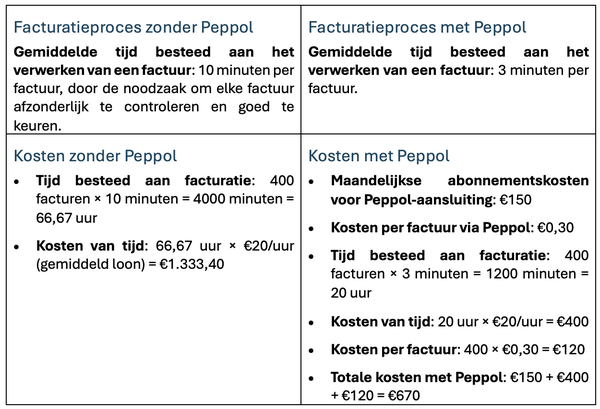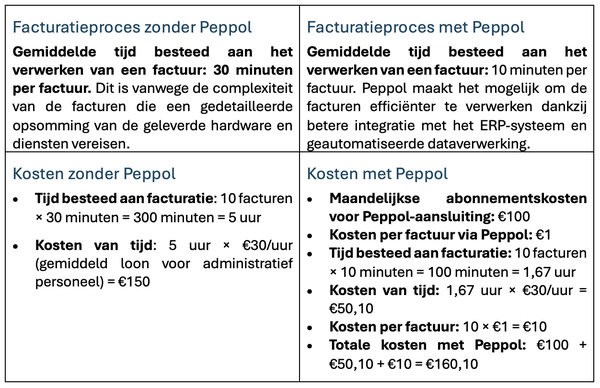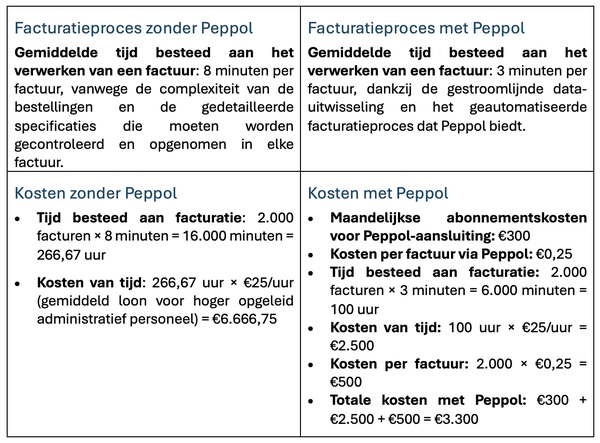Connecting to Peppol: how do I do it?
Do you want to connect to Peppol to send or receive e-invoices or e-orders? This process can be carried out in various ways. For example, through your existing administration software, through a service provider or through a portal. This is a one-off process: once connected to Peppol, you can exchange electronic messages with any organisation worldwide that is also connected to Peppol. 'Connect once, reach all' is what we call this principle. On this page, you can read about the most efficient way for your organisation to connect to Peppol.
Determine the most efficient way to connect
Want to know the best way for your organisation to connect to Peppol? Then determine the way you currently invoice and go through the corresponding steps. This will automatically lead to the most efficient way of connecting. You can then click on connect via your administration software (such as an ERP or accounting package), via a Peppol service provider or via an (invoice) portal at the bottom of the page.
- Check here whether your ERP or accounting package supports Peppol. If so, go through the questions asked on this page. For example, establish whether your package supports the required functionalities and whether you are satisfied with the costs around connecting to and using Peppol. If this is the case, connect to Peppol via your ERP or accounting package.
- Is your ERP or accounting package not listed on this page? If so, ask the software supplier of your package whether Peppol is supported and, if not, whether this is being worked on. It is possible that your supplier has not yet indicated to the NPA that your package supports Peppol, while they do.
- Does your accounting package not support Peppol? Then determine how many e-invoices (or e-orders) your organisation wants to send, whether your organisation also wants to receive invoices via Peppol and what the average invoice size of your e-invoices (or e-orders) is.
Advice around connecting to Peppol
- Do you send a relatively large number of e-invoices or e-orders with and would like to run them automatically through Peppol so that they do not have to be manually entered? In that case, connect to Peppol via a service provider.
- Do you only want to send a small number of e-invoices or e-orders (with a low average invoice size) and/or have no problem transferring them manually to and from your own records? Then use an invoice portal from a Peppol service provider.
- Do you want to send less than 10 e-invoices per month (and not receive e-invoices) and only send them to the central government? Then use the Supplier Portal. Please note, in that case you e-invoice without using Peppol.
Check with your administration or accounting firm whether there are options to connect to Peppol. If not: establish how many e-invoices (or e-orders) your organisation wants to send, whether your organisation also wants to receive e-invoices and what the average invoice size of your e-invoices (or e-orders) is. Then see the heading 'Advice around connecting to Peppol' for the best way to connect to Peppol.
Advice around connecting to Peppol
- Do you send a relatively large number of e-invoices or e-orders with and would like to run them automatically through Peppol so that they do not have to be manually entered? In that case, connect to Peppol via a service provider.
- Do you only want to send a small number of e-invoices or e-orders (with a low average invoice size) and/or have no problem transferring them manually to and from your own records? Then use an invoice portal from a Peppol service provider.
- Do you want to send less than 10 e-invoices per month (and not receive e-invoices) and only send them to the central government? Then use the Supplier Portal. Please note, in that case you e-invoice without using Peppol.
Determine how many e-invoices (or e-orders) your organisation wants to send, whether your organisation also wants to receive e-invoices and what the average invoice size of your e-invoices (or e-orders) is. Then look under the heading 'Advice around connecting to Peppol' on the best way to connect to Peppol.
Advice around connecting to Peppol
- Do you send a relatively large number of e-invoices or e-orders with and would like to run them automatically through Peppol so that they do not have to be manually entered? In that case, connect to Peppol via a service provider.
- Do you only want to send a small number of e-invoices or e-orders (with a low average invoice size) and/or have no problem transferring them manually to and from your own records? Then use an invoice portal from a Peppol service provider.
- Do you want to send less than 10 e-invoices per month (and not receive e-invoices) and only send them to the central government? Then use the Supplier Portal. Please note, in that case you e-invoice without using Peppol.
In doubt? Take a look at the examples or contact the NPA
Unsure which connection method is most efficient for your business? Then take a look at the examples below or contact the NPA. We will be happy to help you!
- Sector: Retail (florist)
- Number of staff: 20 (including florists, delivery staff and administrative staff)
- Peppol clients: Various central government departments
- Number of invoices per month: 400 (a separate invoice for each delivery)
- Average invoice value: Average €32.50 (amounts vary between €15 and €50

Conclusion
The total cost of invoicing with Peppol is €670, compared to €1,333.40 without Peppol. This is a saving of about 50%, partly in time and partly in money. Moreover, automating the process reduces the risk of errors and improves the consistency of invoicing, which is especially important for frequent small transactions.
In addition, Peppol offers benefits when receiving invoices. By saving time (from 10 to 3 minutes per invoice), similar cost savings are achieved, saving both time and money and minimizing errors.
- Sector: Informatie technology
- Number of employees: 30
- Peppol clients: SMEs and government bodies
- Number of Peppol invoices per month: 10
- Average invoice value: €10,000

Conclusion
The total cost of invoicing with Peppol is €160.10, compared to €150 without Peppol. Despite the labour-intensive invoicing process, the cost with Peppol is higher. As more invoices will be sent via Peppol, the cost with Peppol will soon be lower. However, the non-direct financial benefits such as less chance of errors, faster payments due to correct invoices and more efficient customer management should also be taken into account. These benefits can generate significant savings in the short term, but certainly in the longer term, and increase customer satisfaction, which is crucial in a competitive market like ICT hardware. In addition, the minimal cost difference already outweighs having to send invoices manually via a Peppol invoice portal.
In addition, Peppol offers benefits when receiving invoices. By saving time (from 30 to 10 minutes per invoice), similar cost savings are achieved, saving both time and money and minimizing errors.
- Sector: Wholesale
- Number of employees: 50
- Customers: Manufacturing companies and other B2B customers
- Number of invoices per month: 2,000
- Average invoice value: €2,000

Conclusion
The total cost of billing with Peppol is €3,300, compared to €6,666.75 without Peppol. This represents a saving of about 50%. For BulkSupplies B.V., which caters to B2B customers and has to process thousands of complex invoices every month, Peppol delivers significant efficiencies.
Peppol also provides benefits when receiving invoices. The time savings (from 8 to 3 minutes per invoice) can provide similar cost savings, further increasing efficiency.

